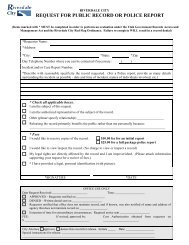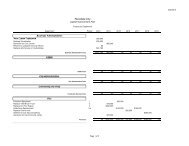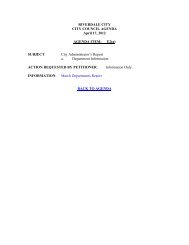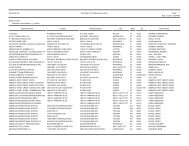Weber River Flood Damage Assessment - Riverdale City
Weber River Flood Damage Assessment - Riverdale City
Weber River Flood Damage Assessment - Riverdale City
Create successful ePaper yourself
Turn your PDF publications into a flip-book with our unique Google optimized e-Paper software.
<strong>River</strong>dale <strong>City</strong> 2011 <strong>Flood</strong> <strong>Assessment</strong> October 13, 2011<br />
many of these levees are located too close to the river, eliminating the connection of the floodplain to<br />
the river. A preferable approach would be to remove these levees, allowing the river to reconnect to the<br />
floodplain. In their place offset levees should be constructed at the limits of the floodplain, along<br />
adjacent property lines, to provide protection for the adjacent residential and commercial properties.<br />
This approach may provide needed overbank conveyance, improve riparian habitat, and eliminate the<br />
nearly annual practice of placing sandbags to protect the community.<br />
Where feasible lay back banks. This may improve conveyance of the main channel while reducing<br />
bank shear stress. This should be done with caution. As previously indicated the <strong>River</strong>dale <strong>City</strong> reach<br />
of the <strong>Weber</strong> <strong>River</strong> has been so constrained that it no longer functions as it did in its natural state. The<br />
river has crossed a transport threshold creating a situation much like placing a collar on tiger. The reach<br />
upstream of <strong>River</strong>dale <strong>City</strong> displays the dynamic behavior of aggradation, point and mid channel bar<br />
formation and the subsequent formation of a new channel. It appears that all of the alluvial material<br />
supplied by the upstream reach is conveyed through <strong>River</strong>dale <strong>City</strong>. There is evidence of aggradation<br />
downstream (Fort Buenaventura Park, Parked Rd. Photo) but almost no evidence of aggradation within<br />
<strong>River</strong>dale <strong>City</strong>. In a sense the <strong>Weber</strong> <strong>River</strong> has become a contained beast within <strong>River</strong>dale <strong>City</strong> and<br />
care should be taken that this beast is not unleashed. Significant aggradation within <strong>River</strong>dale <strong>City</strong><br />
could have detrimental impacts (i.e. Fort BV). The sediment transport of this system, from canyon<br />
mouth downstream to Ogden, needs to be maintained.<br />
We recommend that the <strong>City</strong> revisit the 2005 FIS to ensure that it is still applicable. The FEMA<br />
mapping indicates that the open area between the <strong>River</strong> Bend Subdivision and the <strong>Weber</strong> <strong>River</strong><br />
(Creekside Trailhead) is located in Zone AE (the 100-year flood). As previously indicated, the flood<br />
event of 2011 was on the order of a 15 to 25 year event yet this area was inundated. The FEMA profile<br />
shows that the elevation of the 100-year flood is approximately 2.5 ft higher than the 10 year event.<br />
The Creekside Trailhead and adjacent homes experienced flooding during this event. This flooding may<br />
be the result of an overwhelmed stormwater system and an unusually high groundwater table<br />
combining with the <strong>Weber</strong> <strong>River</strong> <strong>Flood</strong>ing. A 1.5 to 2.5 ft increase in water surface elevation could<br />
significantly impact these residential areas. High groundwater and an overwhelmed stormwater system<br />
would worsen the impact of a 100-Year event. This issue may be address by constructing a stormwater<br />
pump system that increases the conveyance of the existing stormwater infrastructure. However a pump<br />
system may not be effective if it is not incorporated into an associated offset levee to prevent the<br />
recirculation of the pumped stormwater.<br />
16






